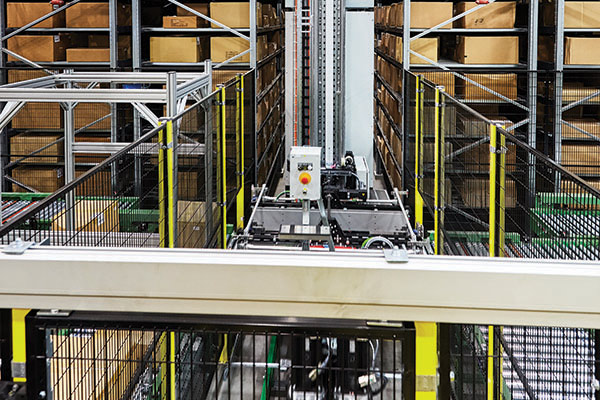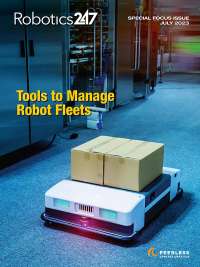It’s November, which means the holiday season is right around the corner. For most retailers, gearing up for peak is a matter of getting the right inventory in the right locations and hiring enough people to get the projected orders out the door.
Those tasks are daunting enough. But, how do you recover when a facility you were counting on for the upcoming season catches fire roughly nine weeks before the first of November?
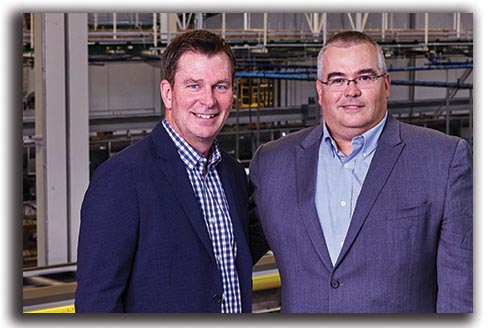
Shawn Curran (left) is executive vice president of Global Supply Chain and Product Operations for Gap Inc. and Kevin Kuntz (right) is senior vice president of global logistics for Gap Inc.
That’s a question Kevin Kuntz, senior vice president of global logistics fulfillment for Gap Inc., and his team confronted on the morning of Aug. 30, 2016. The night before, a fire tore through a 1-million-plus-square-foot distribution center in Fishkill, N.Y. The fire destroyed about $100 million worth of equipment and inventory, and while all employees continued to be paid, hundreds were impacted. What’s more, it took an important order fulfillment asset offline right before peak—a little like losing the starting quarterback on the eve of the Super Bowl. Punting isn’t an option.
“At Fishkill, we were already on our cross-channel logistics journey of building out the shift from retail replenishment to online fulfillment when that fire happened,” says Kuntz. “During the 2015 holiday season, we had done a pop-up location on our Gallatin, Tenn., campus that operated for about 6 to 8 weeks, so we had to move quickly to get that manual pop-up facility back up for the 2016 season and plan for a larger facility for 2017.”
Working with a systems integrator (Vargo), Gap Inc. pulled together a multi-brand, online fulfillment center in Gallatin that represents 500,000 square feet out of a total of 2.5 million square feet on the campus. It fulfills online orders for the Athleta and Banana Republic brands year-round and Old Navy during peak. The campus also includes a 1.2-million-square-foot building servicing Old Navy stores and an 800,000-square-foot building servicing Gap stores and outlets.
While it popped up as a life preserver for the 2016 peak season, the Gallatin campus today is also a showcase for innovation at Gap Inc. and features multiple piece-picking robotic put walls; nine aisles of mini-load and shuttle technology for automatic case storage and handling; a warehouse execution system (WES) for balancing the workload through the facility; a split-tray sortation system; and automatic bagging and trailer-loading technologies.
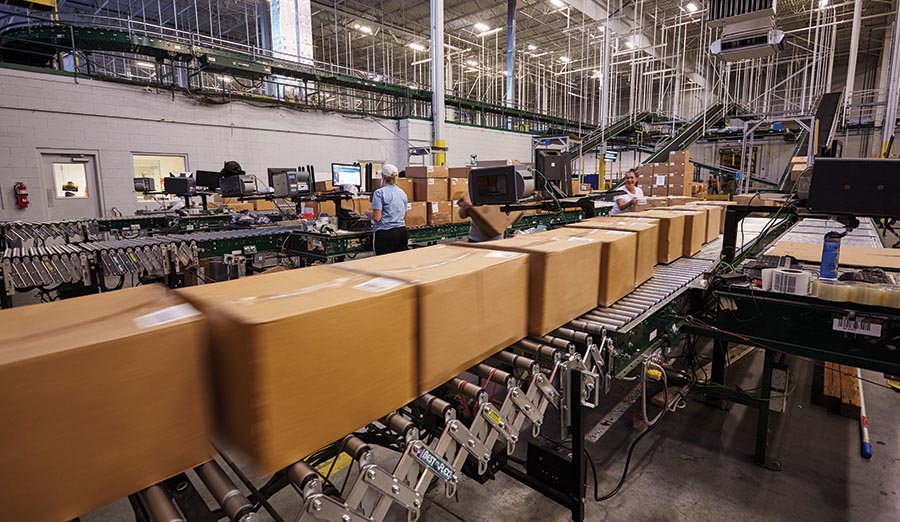
Inbound cartons are conveyorized (top) in the trailer or container and automatically delivered to storage.
It’s a case study in risk management and resilience and an innovative approach to automation. “In the past, distribution was viewed as a cost center and now, because of innovation, it’s a competitive advantage for us,” says Kuntz. “If we can do our job quicker and faster, we get a better seat at the table. It’s been fun and energizing for the logistics team to be part of this.”
Trial by fire
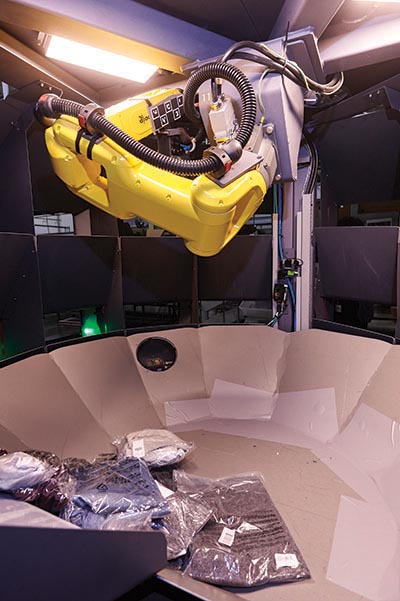 At present, Gap Inc. operates a network of 10 distribution centers in North America to handle store replenishment and e-commerce, a total of 8.8 million square feet. There are two distribution centers in Fishkill, N.Y.; a large facility dedicated to e-fulfillment in Columbus, Ohio; three DCs in Gallatin, Tenn.; an e-fulfillment facility in Phoenix; two distribution centers in Fresno to serve the West Coast; and one facility in Canada. At one time, 14 buildings were in the network, but the company’s capacity and workforce allowed them to transform their campuses from single-channel operations to cross-channel fulfillment operations that leverage cutting-edge technology and automation—an initiative they call Cross-Channel Logistics Optimization (CCLO). As a result, Gap Inc. was able to reduce its footprint down to 10 distribution centers in North America while also increasing capacity. That’s the power of innovation.
At present, Gap Inc. operates a network of 10 distribution centers in North America to handle store replenishment and e-commerce, a total of 8.8 million square feet. There are two distribution centers in Fishkill, N.Y.; a large facility dedicated to e-fulfillment in Columbus, Ohio; three DCs in Gallatin, Tenn.; an e-fulfillment facility in Phoenix; two distribution centers in Fresno to serve the West Coast; and one facility in Canada. At one time, 14 buildings were in the network, but the company’s capacity and workforce allowed them to transform their campuses from single-channel operations to cross-channel fulfillment operations that leverage cutting-edge technology and automation—an initiative they call Cross-Channel Logistics Optimization (CCLO). As a result, Gap Inc. was able to reduce its footprint down to 10 distribution centers in North America while also increasing capacity. That’s the power of innovation.
As with many retailers competing in the online space, the catalyst for innovation at Gap Inc. over the past five years has been the growth of e-commerce. “When our online business was merged into our overall logistics organization, it became clear that technology and innovation would be necessary to keep up with the growth of e-commerce.” The subtext: E-commerce is labor intensive, especially at peak, and retailers and e-tailers alike are congregating in the same logistics hubs, going after the same finite labor resource.
“We were hiring thousands of people during peak seasons across our network,” Kuntz says. “When you tax markets like that, you quickly find out how hard it is to find that much labor.”
But innovation isn’t just an e-fulfillment phenomenon. In its retail fulfillment operations, Gap Inc. hasn’t performed a manual pick from a pick module in the past three years, according to Kuntz. Cartons are put away into storage in a mini-load system and mixed-carton orders are assembled at a goods-to-person station serviced by shuttle systems. When an allocation drops, a carton is pulled from the mini-load or from the shuttle. If the carton’s contents are consumed, it goes back into storage. Otherwise, it goes to shipping. “In retail fulfillment, we now just touch a carton when we unload it from the truck and, for full cartons, when it gets to a sorter,” Kuntz says. “We have reclaimed so much space in our distribution centers because we don’t have pick modules for retail fulfillment any more. Only in our e-commerce operations.”
Robotic picking brings together AI, Big Data and machine learning
It’s easy to think of robotics, Big Data, artificial intelligence (AI) and machine learning as four distinct things. But according to a recent presentation by George Babu, the co-founder of Kindred, the robotic startup whose put wall technology is now in use at two Gap Inc. distribution centers, the four come together when a robot is tasked to pick an item.
When the robot is presented with an item it has picked before, it has a history (think Big Data) to draw from—accessing its database, it knows how it picked the item before. But what happens when it is presented with an unfamiliar item?
First, using vision and sensors, it scans the item; artificial intelligence—think of it as applying past experience—identifies the area where the robot thinks it can pick up the item. If that pick is successful, that information becomes part of the robot’s historical database that can inform picking another item that looks similar—think Big Data.
If unsuccessful, a robot pilot—a human at a remote location who is monitoring Kindred’s robots in the field much like a remote drone pilot—can take over the controls and direct the robot to pick the item. Based on that experience, the robot learns how to pick that item the next time it sees it. And that’s machine learning. All of these technologies are building on one another to make the robotic technology a success.
In the summer of 2016, Gap Inc. was in the midst of remaking one of the Fishkill facilities to expand its e-fulfillment capacity by 300,000 units a day by the start of peak. Then the fire struck in late August. As it turns out, that’s the kind of thing considered in Gap Inc.’s risk management playbook. “We drill for these kinds of events,” Kuntz says. “When you’re sitting through some hardcore simulations, it seems a little far-fetched, but not now.
The night of the fire, they were on the job. While leaders at Fishkill confirmed all employees were safely accounted for, Kuntz and his team brought out the playbook and reviewed their options. Planning began by revisiting the pop-up site in Gallatin and creating an additional pop-up site on the Fishkill campus. Team members got on the phone to redirect freight to other locations. The next morning, all Fishkill employees were informed they would not miss a paycheck, even on the days when they didn’t come into work.
Those were solutions to the short-term problem of how to survive the upcoming holiday season. The longer-term solution they needed to figure out was how to replace the 300,000-units-a-day capacity Fishkill was supposed to provide before the facility burned nearly to the ground. How do you survive a trial by fire?
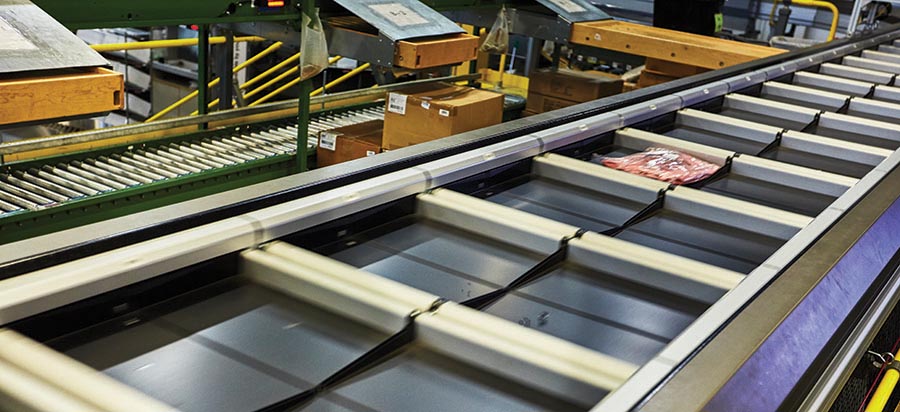
Picked items are routed to packing by a split-tray sorter.
Shortly after that night, Kuntz received a call from Vargo, the WES software provider and system integrator based in Columbus, Ohio. Vargo was already working with Gap Inc. to use its WES at Fishkill. Given industry lead times, it would take 18 months to get new equipment, meaning a good two years before Fishkill could go live. But, perhaps, another solution was out there. “We had a customer in Pennsylvania that had shut down a building that was using our WES software and had conveyor and a bomb bay (split-tray) and shipping sorter,” recalls Art Eldred, Vargo’s client executive for systems engineering. In short order, Gap Inc. had made a deal to purchase and ship the equipment to Gallatin, where it would be ready to go after the season was over.
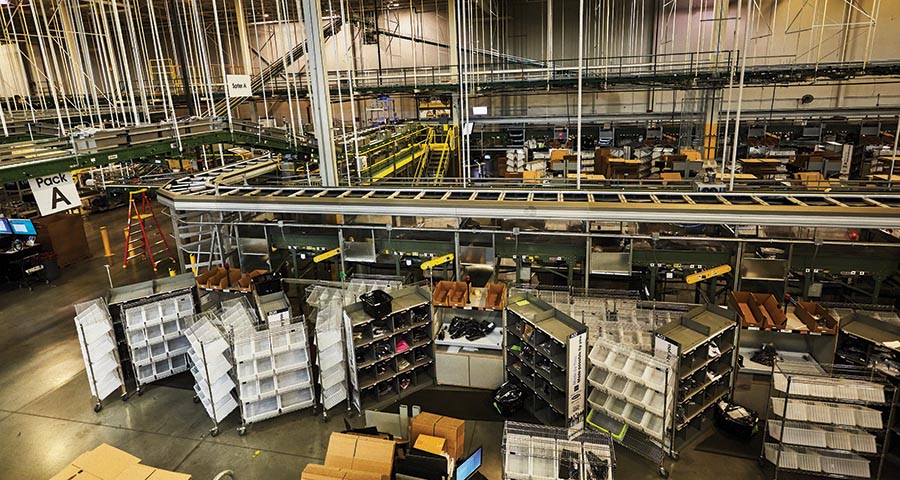
Multi-line orders are assembled in a put wall area.
Somehow, it worked. “What I remember most is how many hours we asked our employees to work that season,” Kuntz says. “They were the unsung heroes, working a lot of 70-hour weeks. But, all of the retail stores got serviced, and we kept up with online demand.”
Phasing in automation
At the start of 2017, with the 2016 peak in the rear-view mirror, Gap Inc. began planning to transform the 500,000-square-foot Gallatin facility into a highly automated, cross-channel fulfillment operation, serving online and retail for the Athleta brand.
“Post peak, the split-tray sorter was waiting for us,” Kuntz says. “We immediately started dismantling racks to make room for the sorter; we moved the existing pick module to a different part of the warehouse and moved in a four-level pick module.”
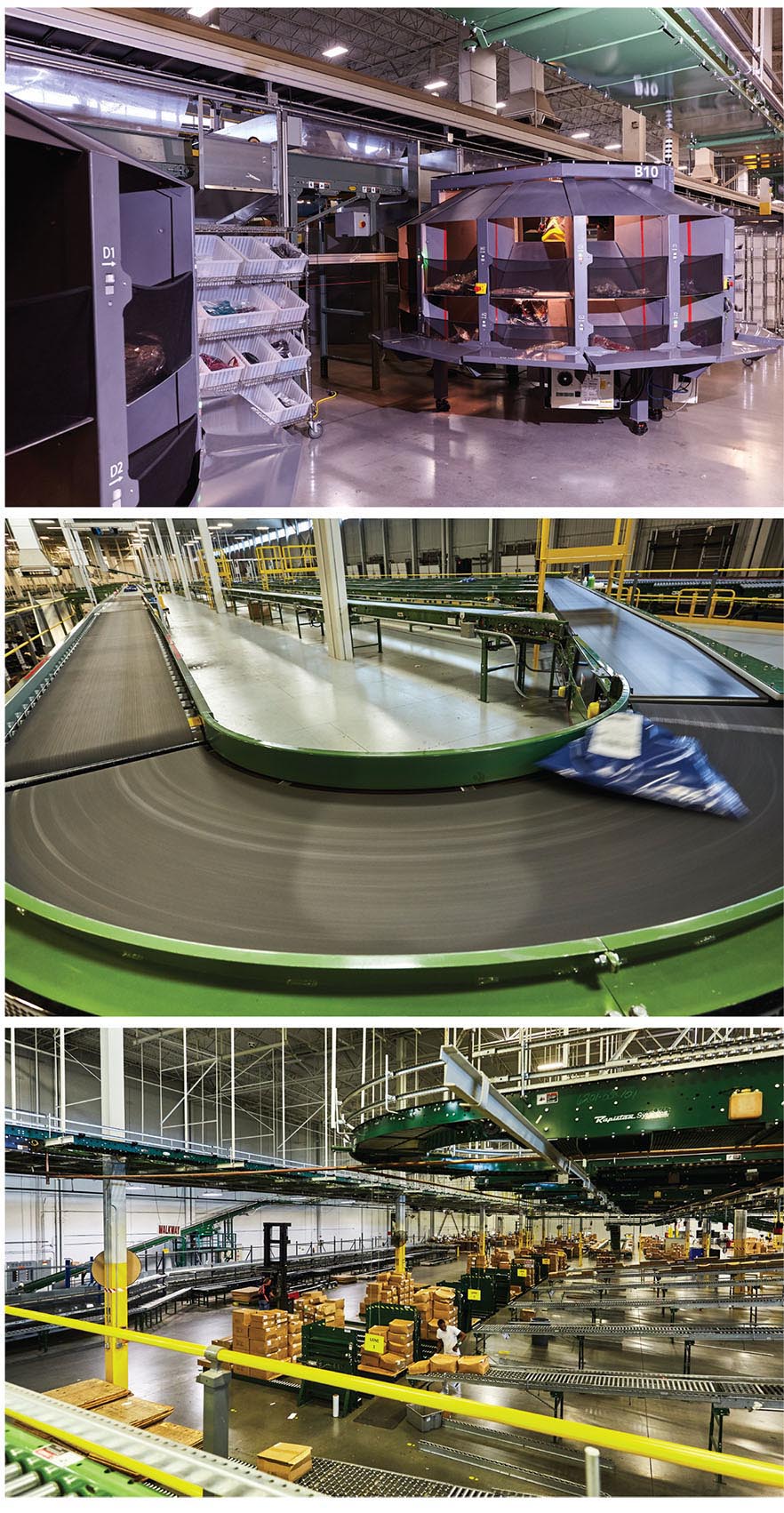
The Gallatin facility includes a number of spherical robotic put walls (top). Items are conveyed to packing (middle). Packed orders are sorted to shipping (bottom).
The project was going to be completed in phases. In 2017, phase one focused on conveyor and sortation. Cartons were automatically received onto an inbound conveyor system and sorted to value-added services as needed or to conventional carton storage. Items picked in the four-level pick module were inducted onto the split-tray sorter and conveyed to packing at put wall stations. It was all tied together with the WES system in a waveless picking process that interleaved e-commerce and store replenishment for the Athleta brand. Rather than create pick waves, the software pulls work through the facility to maintain a constant flow of activity on the machines, keeping them busy for the full 60 minutes in an hour.
The work was completed in August of 2017. The results met expectations. “That holiday, we averaged about 110,000 packages a day following a go-live that was just 2.5 months earlier.”
Kuntz adds that despite the speed at which the equipment and software was implemented, very few issues arose from a system standpoint. “The WES software is impressive when it comes to self-healing,” he says. “You go to a location and if it’s short-picked, the software orders replenishment for the pick location and sends a carton with the shorted material to the pack location. Everything is hot picked from reserve storage.”
In 2018, phase two saw the implementation of nine aisles of automated storage, both crane-based mini-load for high-density storage and shuttle storage. That equipment will now be in place for this year’s holiday season.
Robotic put wall
Gap Inc. describes itself as an organization unafraid to innovate, even if only some of the projects result in a technology that goes live (see box below). “A lot of folks hate change,” says Kuntz. “If you’re going to do innovation, you have to have people who enjoy change and making things work. Rather than being skeptical, our attitude is: How do I make it work?”
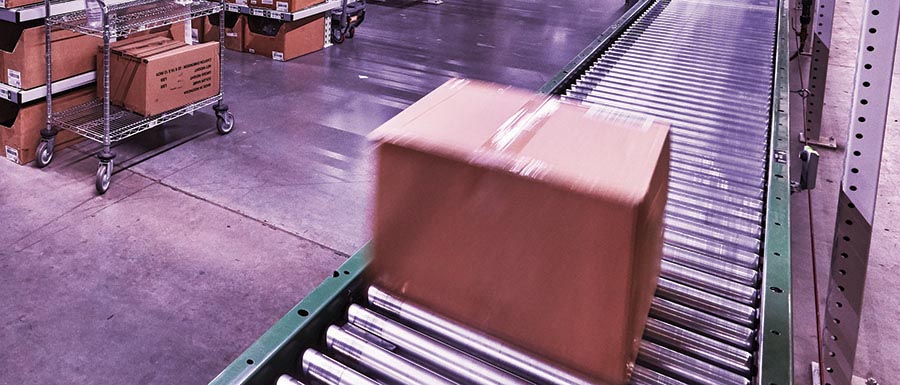
Inventory is stored in bins on shelf locations in the pick module.
Gap Inc.’s innovation lab
Innovation is a process, one that Gap Inc. has embraced at its Gallatin, Tenn., facility. “We do embody the spirit of innovation at Gap Inc., and we pride ourselves on our test-and-learn culture,” says Kevin Kuntz, Gap Inc.’s senior vice president of global fulfillment. “We like to try new things, and if it doesn’t work out, you move on, and if it does work out, we scale it out across our network.”
There are four factors behind the Gap Inc.’s approach to innovation:
- Fail fast and move on: “We typically do a number of small proof of concepts, but not all of them take off,” Kuntz says. “The culture here encourages us to learn from these trials and iterate. If an idea doesn’t work, you move on.
- Executive buy-in counts: Kuntz says that his team is fortunate to work for a retailer that is financially healthy, with an executive team that is willing to provide the capital for an innovation culture.
- Collaborate with vendors: When you’re trying to run a number of proof-of concepts, you want to limit the size of your investment up front. To that end, Gap Inc. collaborates with solution providers so everyone has some skin in the game, whether the pilot works or fails. “We tell our partners that we’re going to give them a lab and a real-life environment to test their solutions,” Kuntz says. “Since we have a reputation for being willing to give something a try, vendors are willing to partner with us at a lower cost. If it works, it’s a win for them.”
- Start small, then scale: When TGW was moving into the United States, Gap Inc. agreed to test its mini-load technology to handle cardboard boxes rather than totes. “We started with just two aisles of storage in 2012 and were able to prove the concept,” Kuntz says. “Today, we have about 58 aisles across the network with more going in.” The same approach was followed with the Kindred robotic put walls, starting with two stations in Gallatin before expanding to six in that facility, and later scaling to a handful more at the Fresno campus.
Ideas typically come from ProMat and Modex, the two major North American materials handling trade shows. At ProMat 2017, Gap Inc.’s supply chain team came across a piece-picking robot from Kindred AI, a California-based company that was initially designed to move items from one tote to another.
The AI and robotics company also built SORT, a 360-degree sphere with a robotic arm and cubbies like a put wall. Following ProMat, Kindred brought a prototype to Gap Inc.’s Fresno distribution center. “We looked at it and thought, with some modifications, we could make it work as an alternative to a human packing station,” Kuntz says. “We decided to do a proof of concept.”
To make it work, Vargo adapted its software to provide a put location for the robotic product. The chutes feeding the two put walls are destination locations for the split-tray sorter. Each sphere has 20 cubbies, compared to 32 in a normal put wall. When items drop into one of the robotic spheres, the robot uses a vision system to determine how to grasp the item.
When the robot presents the picked item to a fixed scanner, the WES identifies the cubby location for the put. In anticipation of the 2017 holiday season, two of the robotic put walls were installed in the Gallatin facility. According to Kuntz, the put walls were up and in production within two days of their arrival. Autonomous picking started at 20% and has increased to over four times since the partnership first began.
“We worked through that 2017 holiday season with the two units and gave feedback on what was and wasn’t working,” says Kuntz. “We worked with Kindred to make modifications and saw lot of potential to expand the solution.” Currently six robotic put walls are at work in Gallatin, and even more have been installed in Fresno.
A little more than two years since the fire, Gap Inc. has not only risen from the ashes, it has moved its automation capabilities further, with more on the horizon. “We have a great group of people that loves making things better, faster and cheaper,” Kuntz says. “Our special sauce is that success has built our confidence, and the team enjoys looking at opportunities to lower costs and increase speed.”
About the Author
Follow Robotics 24/7 on Linkedin
About the Author
Follow Robotics 24/7 on Linkedin
Article topics
Email Sign Up

